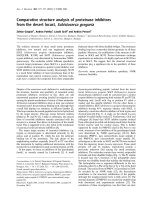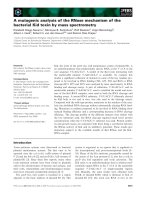Báo cáo khoa học: "Quantitative physico-chemical analysis of the acidosis of cardiac arres" ppsx
Bạn đang xem bản rút gọn của tài liệu. Xem và tải ngay bản đầy đủ của tài liệu tại đây (32.92 KB, 2 trang )
347
A
TOT
= total weak acid concentration; p
CO2
= partial pressure of CO
2
; SID = strong ion difference; SIG = strong ion gap.
Available online />Abstract
Metabolic acidosis is a common finding after cardiac arrest. Until
recently this acidosis was mainly attributed to lactate. The physico-
chemical approach to acid–base balance permits the detection of
previously unmeasured ions. These ions have been shown to affect
the acid–base status of patients.
Introduction
The acid–base disturbance in patients suffering cardiac
arrest is more complex than previously thought. Makino and
colleagues have presented a quantitative assessment of the
components that create the disturbance [1]. As previously
reported, hyperlactatemia is not the sole cause of metabolic
acidosis in the patient after arrest [2]. The physico-chemical
approach permits the detection of unmeasured ions and the
measurement of their effect on the patient.
The physico-chemical approach
The authors present a concise review of the physico-chemical
approach to acid–base balance using the Stewart–Figge
methodology [3,4]. This concept is based on the principles of
electric neutrality and the conservation of mass. There are three
independent variables that determine blood pH: partial pressure
of CO
2
(p
CO2
), total weak acid concentration (A
TOT
) and the
strong ion difference (SID). p
CO2
is an independent variable.
Ions that are fully dissociated at physiologic pH are known as
strong ions. The difference between the strong cations, such as
sodium, and the strong anions, such as chloride, is SID. Weak
acids (A
TOT
) also carry a charge; these are principally albumin
and phosphate. In keeping with the principles of electric
neutrality, the difference between the charges will be zero
unless there are unmeasured ions present. This difference is
known as the strong ion gap (SIG). A more in-depth review and
an Excel-based macro program can be found at The Acid Base
pHorum [5].
The study
Makino and colleagues performed their prospective obser-
vational study in Japan. In that country there is no pre-hospital
administration of medication. Blood samples were drawn on
arrival before any iatrogenic manipulation. This allows a
relatively rare opportunity to collect and study unaltered
human cardiac arrest data. The authors comment that some
intravenous fluid might have been started immediately before
blood draw. Saline-based intravenous fluids are well known
to create an acid–base disturbance, in particular a nongap
hyperchloremic metabolic acidosis [6–8]. The fluid used
during resuscitation was Ringer-based, which has a much
smaller effect on the acid–base balance.
The comparison group was composed of 28 patients who
suffered minor injuries and were discharged within 2 days.
This group was chosen because all of the necessary blood
samples were drawn on arrival. Given their minor injuries and
short hospitalization, they were considered to be baseline
‘normal’. The authors do comment on the fact that the
comparison group initially had a mildly elevated lactate level.
However, all other variables in the comparison group were
normal. Although not optimal, that, in combination with the
large difference in lactate between the study and comparison
groups, does permit an adequate comparison.
This study had only a small number of patients enrolled. The
patients suffered cardiac arrest from a variety of causes, both
from physiologic disease and from trauma. Presumably
because of the small number of patients enrolled they did not
evaluate differences between the groups. Twelve percent of
the patients are listed as ‘other’ for the cause of their cardiac
arrest. This is the same proportion of patients who suffered
cardiac arrest from trauma. This group of unknowns can
certainly skew the results. For example, perhaps this group
Commentary
Quantitative physico-chemical analysis of the acidosis of cardiac
arrest
Heatherlee Bailey
Associate Program Director of Emergency Medicine, Assistant Professor of Emergency Medicine, Drexel University College of Medicine, Philadelphia,
PA, USA
Corresponding author: Heatherlee Bailey,
Published online: 22 July 2005 Critical Care 2005, 9:347-348 (DOI 10.1186/cc3770)
This article is online at />© 2005 BioMed Central Ltd
See related research by Makino et al. in this issue [ />348
Critical Care August 2005 Vol 9 No 4 Bailey
ingested toxic alcohols, which would lead to severe metabolic
acidosis. If this group had been evaluated separately, it might
have led to a different outcome.
Only 10% of the patients had witnessed arrest. It is not
surprising that the initial rhythm in more than 50% of the
study patients was asystole. Nineteen percent of the arrest
group had a return of spontaneous circulation. Unfortunately
the authors did not comment on the outcome data for this
group. What was the duration of survival? Obviously the
numbers are small, only 20 patients. It would be interesting to
know whether there was any trend or difference between
survivors and nonsurvivors. In a study on vascular injury
patients, a SIG of more than 5 was shown to be a marker for
mortality [9].
Unmeasured ions
Unmeasured ions determined only by using the SID/SIG
methodology have been discovered in a variety of patients:
critically ill [10], trauma [11,12], pediatric [13] and now after
cardiac arrest [1]. Recently Martin and colleagues reviewed
data from more than 400 patients from their trauma intensive
care unit [12]. Unmeasured ions were found in 92% of
patients and were the most common component of metabolic
acidosis in these patients. More importantly, 28% of patients
had a different clinical interpretation and would have received
different therapy if the physico-chemical approach had been
used rather than the standard method that was used.
Conclusion
The acid–base derangement in the post-arrest victim is
complex. Previously unrecognized factors contribute to the
metabolic acidosis in equal amounts to that of lactate. The
presence of unmeasured ions alters the clinical interpretation
and treatment of the patient. This study has identified another
area that needs further investigation to determine the
significance of the presence of unmeasured ions in the post-
arrest patient.
Competing interests
The author(s) declare that they have no competing interests.
References
1. Makino J, Uchino S, Morimatsu H, Bellomo R: A quantitative
analysis of the acidosis of cardiac arrest: a prospective obser-
vational study. Crit Care 2005, 9:R357-R362.
2. Prause G, Ratzenhofer-Comenda B, Pierer G, Smolle-Juttner F,
Glanzer H, Smolle J: Comparison of lactate or BE during out of
hospital cardiac arrest to determine metabolic acidosis.
Resuscitation 2001, 51:297-300.
3. Stewart PA: Modern quantitative acid–base chemistry. Can J
Physiol Pharmacol 1983, 61:1444-1461.
4. Figge J, Mydosh T, Fencl V: Serum proteins and acid–base
equilibria: a follow-up. J Lab Clin Med 1992, 120:713-719.
5. Kellum JA: The acid base pHorum [ />education/resources/phorum.html]
6. Scheingraber S, Rehm M, Semisch C, Finsterer U: Rapid saline
infusion produces hyperchloremic acidosis in patients under-
going gynecologic surgery. Anesthesiology 1999, 90:1265-
1270.
7. Waters JH, Miller LR, Clack S, Kim JV: Cause of metabolic aci-
dosis in prolonged surgery. Crit Care Med 1999, 27:2142-
2146.
8. Prough DS, Bidani A: Hyperchloremic metabolic acidosis is a
predictable consequence of intraoperative infusion of 0.9%
saline. Anesthesiology 1999, 90:1247-1249.
9. Kaplan LJ, Kellum JA: Initial pH, base deficit, lactate, anion gap,
strong ion difference, and strong ion gap predict outcome
from major vascular injury. Crit Care Med 2004, 32:1120-
1124.
10. Gunnerson, KJ, Kellum JA: Acid–base and electrolyte analysis
in critically ill patients: are we ready for the new millennium?
Curr Opin Crit Care 2003, 9:468-473.
11. Kaplan LJ, Bailey H, Kellum J: The etiology and significance of
metabolic acidosis in trauma patients. Curr Opin Crit Care
1999, 5:458-463.
12. Martin M, Murray J, Berne T, Demetriades D, Belzberg H: Diagno-
sis of acid-base derangements and mortality prediction in the
trauma intensive care unit: the physiochemical approach. J
Trauma 2005, 58:238-243.
13. Balasubramanyan N, Havens PL, Hoffman GM: Unmeasured
anions identified by the Fencl–Stewart method predict mortal-
ity better than base excess, anion gap, and lactate in patients
admitted in the pediatric intensive care unit. Crit Care Med
1999, 27:1577-1581.









